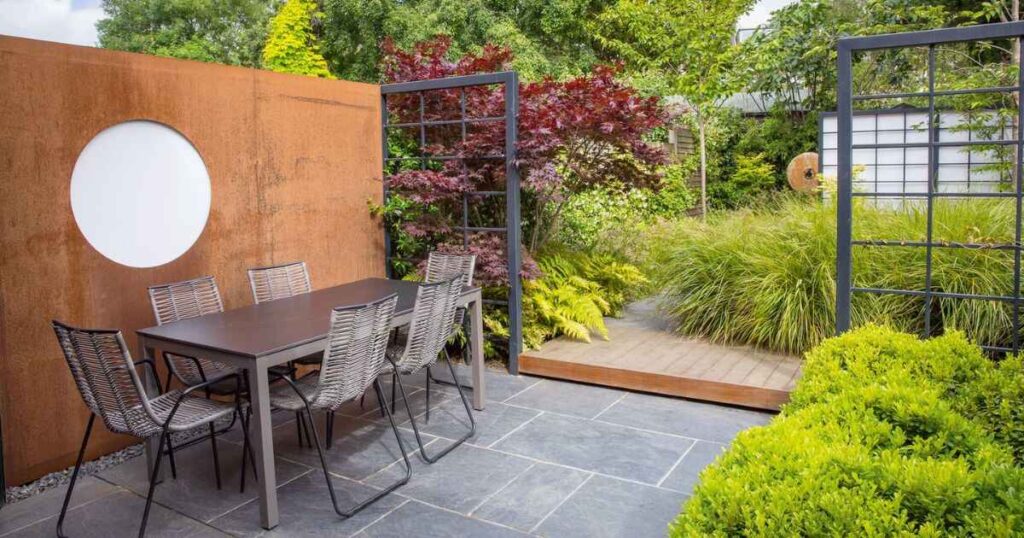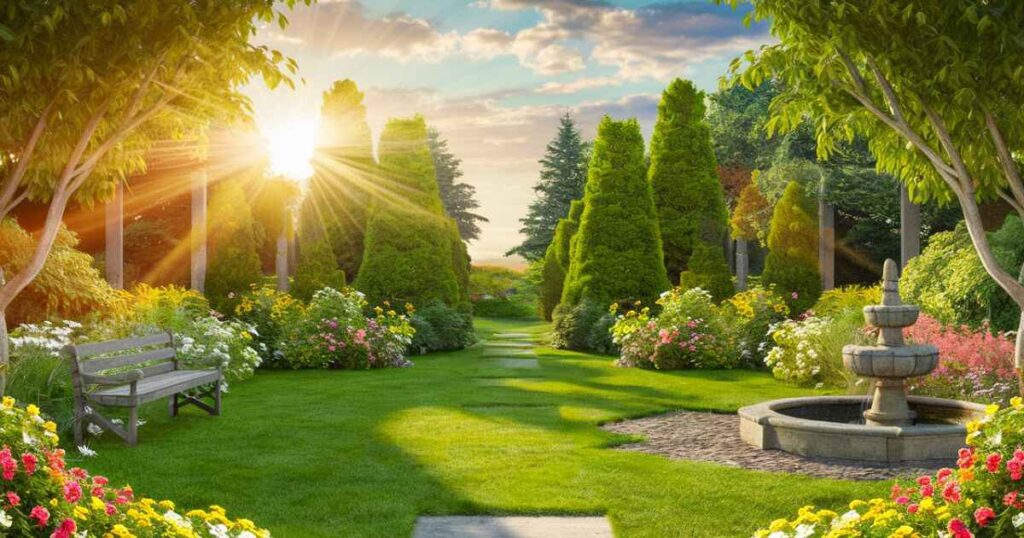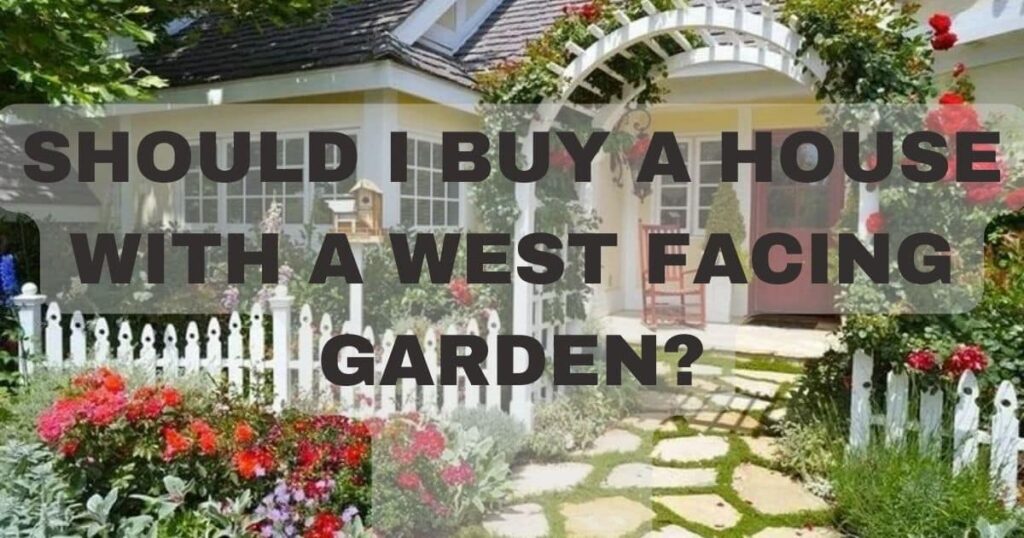When searching for a new home, one often-overlooked factor is the orientation of the garden. While many homebuyers prioritize features like square footage, location, and number of bedrooms, the direction your backyard faces can significantly impact your living experience.
In this article, we’ll explore the pros and cons of buying a house with a west facing garden, helping you make an informed decision that aligns with your lifestyle and preferences.
What is a West Facing Garden?

A west facing garden is exactly what it sounds like – a backyard or outdoor space that faces towards the west. This orientation means that the garden receives direct sunlight during the afternoon and evening hours, as the sun sets in the western sky. Determining the direction of a garden is relatively simple. You can use a compass or a compass app on your smartphone, or even refer to online maps and satellite imagery.
In general, a west facing garden will start to receive sunlight around 1 pm and continue to bask in the warm rays until sunset. However, it’s important to note that factors such as nearby trees, buildings, or other structures can impact the amount of direct sunlight the garden receives throughout the day.
Pros of Buying a House with a West Facing Garden
Energy Efficiency and Lower Utility Bills
One of the most significant advantages of a west facing garden is the potential for energy savings and lower utility bills. Since the backyard receives direct sunlight during the afternoon and evening hours, the interior of the house will be naturally illuminated, reducing the need for artificial lighting.
This natural light can be particularly beneficial during the warmer months when daylight hours are longer, allowing you to minimize the use of energy-intensive light bulbs and fixtures. As a result, you may see a noticeable reduction in your monthly energy bills, making a west facing garden an eco-friendly and cost-effective choice.
Extended Daylight Hours for Outdoor Activities
For those who love spending time outdoors, a west facing garden offers extended hours of enjoyment. With the sun shining directly into the backyard during the afternoon and evening, you can take advantage of the warmth and light for a variety of outdoor activities.
Imagine hosting a barbecue or outdoor gathering that lasts well into the night, without the need for excessive artificial lighting. Or, if you have a green thumb, a west facing garden provides ample opportunity to tend to your plants and garden during the cooler evening hours.
Ideal for Certain Plants and Flowers
Speaking of gardening, a west facing garden can be an ideal environment for certain types of plants and flowers. Many species thrive in the warm, afternoon sunlight, producing vibrant blooms and lush foliage.
Some examples of plants that excel in west facing gardens include:
- Roses
- Tulips
- Jasmine
- Tomatoes
- Peppers
- Herbs (basil, rosemary, thyme)
With the right planning and plant selection, your west facing garden can become a verdant oasis, bursting with color and fragrance throughout the growing season.
Shaded Mornings are Family Friendly
If you have young children, a west facing garden can be a blessing in disguise. During the morning hours, the backyard will be shaded, providing a cool and comfortable environment for outdoor play.
This shaded respite can be especially beneficial during the hot summer months, allowing kids to burn off energy without the risk of excessive sun exposure or sunburn. As a parent, you can relax knowing your little ones can enjoy the great outdoors safely during the cooler morning hours.
Read More About: BUILDING SOCIETY ROLL NUMBER: EVERYTHING YOU NEED TO KNOW
Cons of Buying a House with a West Facing Garden
While a west facing garden offers several advantages, it’s important to consider the potential drawbacks as well.
Increased Afternoon Heat Indoors
During the summer months, the intense afternoon sun beaming into a west facing garden can lead to increased indoor temperatures. Rooms facing the backyard may become uncomfortably warm, necessitating the use of air conditioning or fans to maintain a comfortable living environment.
This increased need for cooling can result in higher energy costs, potentially offsetting some of the savings from reduced lighting requirements. However, proper insulation, window treatments, and strategic landscaping can help mitigate this issue.
Less Desirable Than South Facing for Resale
In the real estate market, south facing gardens are generally considered the most desirable orientation, as they receive direct sunlight throughout the day. As a result, houses with west facing gardens may not command as high a price as their south-facing counterparts when it comes time to sell.
While this should not be the sole determining factor in your home purchase decision, it’s worth considering if you plan to resell the property in the future. The potential impact on resale value may be more significant in certain regions or markets.
Limited Kid’s Playtime in Peak Heat
While the shaded mornings of a west facing garden can be a boon for families with young children, the afternoon heat can limit outdoor playtime during the hottest hours of the day.
During the summer months, the intense afternoon sun can make the backyard uncomfortably warm, potentially forcing kids to seek indoor entertainment or alternative activities. This limitation may be particularly challenging for families with active children who thrive on outdoor playtime.
Potential for Excessive Morning Sun in Front Rooms
While the backyard of a west facing garden enjoys shaded mornings, the front rooms of the house may experience the opposite effect – excessive morning sun.
Depending on the orientation of the front of the house, east-facing rooms may receive direct sunlight during the early morning hours, leading to potential issues with glare and overheating. In some cases, homeowners may need to invest in window treatments or blinds to regulate the amount of light entering these spaces.
Is West or South Facing Better?

Ultimately, the question of whether a west or south facing garden is better comes down to personal preferences and lifestyle factors. While south facing gardens are generally considered the most desirable orientation, west facing gardens offer their own unique advantages.
If you value evening outdoor activities, gardening opportunities, and energy savings from reduced lighting needs, a west facing garden may be the perfect fit. However, if you prioritize maximum sunlight exposure throughout the day or are concerned about potential resale value, a south facing garden could be the better choice.
It’s also worth noting that a west facing garden can be a happy medium for those who want to enjoy both morning and evening sun exposure. The front of the house will receive morning light, while the backyard basks in the evening rays.
Other Factors to Consider
When evaluating the suitability of a west facing garden, it’s important to consider additional factors that can impact sunlight exposure and overall enjoyment of the outdoor space:
- Landscaping and Trees: Mature trees or dense landscaping in the backyard or on neighboring properties can cast shadows and reduce the amount of direct sunlight the garden receives.
- Size and Layout: The size and layout of the garden can influence how much direct sunlight it receives and how usable the space is for outdoor activities.
- Home Insulation and Cooling Systems: Well-insulated homes with efficient cooling systems may be better equipped to handle the increased afternoon heat from a west facing garden.
It’s always a good idea to thoroughly evaluate the property, considering all potential factors that could impact your living experience.
Conclusion
Buying a house with a west facing garden can be a wonderful choice for those who value outdoor living, gardening opportunities, and potential energy savings. However, it’s essential to weigh both the pros and cons carefully, taking into account your personal preferences, lifestyle, and future plans.
By considering factors such as increased afternoon heat, resale value, and limitations on outdoor playtime during peak hours, you can make an informed decision that aligns with your priorities.
Remember, there is no one-size-fits-all solution when it comes to garden orientation. What matters most is finding a home that meets your unique needs and allows you to create lasting memories in your outdoor oasis, whether it’s basking in the evening sun or enjoying shaded mornings with your family.







